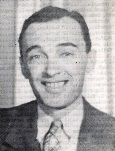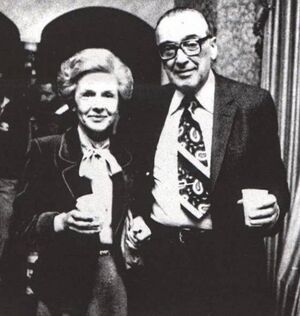A. E. van Vogt

(April 26, 1912 – January 26, 2000)
Alfred Elton van Vogt, aka V2 (né Alfred Vogt, last name pronounced "VOTE"), known as "Van" to his friends, was a Canadian-born SF writer. He was one of John W. Campbell's discoveries who ushered in the Golden Age of Astounding. He moved to LA in the mid-40s and lived there the rest of his life. A major writer, he was considered one of the Big Three.
He was active fannishly in LASFS in the early days. He founded SFWPA.
His novel Slan had an enormous impact on fandom, with many fans seeing themselves as slans. Van Vogt coined the term fix-up and used it in his autobiography Reflections of A.E. van Vogt: The Autobiography of a Science Fiction Giant, with a Complete Bibliography (1975); he likely compiled more fixups than any other sf writer of stature.
He always had a taste for the scientifically dubious (he was heavily influenced by Alfred Korzybski), but his career went into eclipse when he turned to Dianetics in the early ’50s, and did not really recover when he again took up writing in the ’60s. On the other hand, his story “Far Centaurus” is still cited today in scientific work.
Van Vogt's agent was Forrest J Ackerman. The Canadian A. E. van Vogt Award was created in his honor, while the Aurora Award was first named The Coeurl after the monster in one of van Vogt's early stories.
Contents
Personal Life[edit]

He was married to E. Mayne Hull, also a writer of SF and fantasy, who wrote the "Artur Blord" series for Unknown. They collaborated on Out of the Unknown (1948) and Planets for Sale (1954).
He was born on his grandparents' farm in Edenburg, Manitoba. Until he was 4, van Vogt and his family spoke only Plautdietsch, a German dialect, at home.
After Hull’s death in 1975, van Vogt married Lydia Bereginsky in 1979. They were together till his death from Alzheimer’s Disease in 2000.
His papers are at the Kenneth Spencer Research Library, University of Kansas.
More[edit]
- Entry in The Encyclopedia of Science Fiction.
- Lan's Lantern 37, May 1991, A. E. van Vogt special issue.
- Sevagram, van Vogt tribute site.
- Tribute to van Vogt in Paperback Parade #103 (February, 2019).
Awards, Honors and GoHships:
- 1946 -- Pacificon
- 1948 -- 1948 Fantasy Annual Top Author
- 1972 -- Forry Award
- 1976 -- Rhocon I
- 1977 -- Clayton Con, HBHS Minicon
- 1978 -- V-Con VI, Chattacon 3
- 1979 -- Loscon 6, ConClave IV
- 1989 -- CopperCon 9
- 1990 -- LibertyCon 4
- 1995 -- Archon 19, SFWA Grand Master Award
- 1996 -- L.A.Con III Special Committee Award, Science Fiction Hall of Fame, finalist for 1946 Best Novelette Retro Hugo and 1946 Best Novel Retro Hugo
- 1997 -- Norwescon XX
- 2014 -- Canadian Science Fiction and Fantasy Hall of Fame
- 2016 -- 1941 Best Novel Retro Hugo
Major Works[edit]
Slan[edit]
Slan (September–December 1940 Astounding) is his best-remembered novel, for reasons that have more to do with fannish reaction than its quality. See Slan for details.
Awards and Honors
- 2016 — 1941 Best Novel Retro Hugo
The Weapon Shops of Isher[edit]
The Weapon Shops of Isher (July 1941 and December 1942 Astounding) and its sequel The Weapon Makers (February–April 1943 Astounding), gave fandom the catchphrase “The right to buy weapons is the right to be free” and the mysterious term Sevagram.
Null-Ā[edit]
The World of Ā (August–October 1945 Astounding) and The Pawns of Null-A (October 1948–January 1949 Astounding) popularized the concepts of Null-Ā (non-Aristotelian logic) and Alfred Korzybski's General Semantics.
It was infamously demolished by the young critic damon knight in Destiny's Child.
“Far Centaurus”[edit]
An influential short story by van Vogt, first published in Astounding in January 1944, “Far Centaurus” is written from the point of view of a crewman on the first (very much Slower Than Light) interstellar ship. After hundreds of years (the crew is in cold sleep) they awaken in the Alpha Centauri system to find it a bustling human civilization: While they were plodding through space, humanity developed an FTL drive and settled all the nearby stars.
This problem -- sometimes called the "Incentive Trap" -- is a very real one and is being considered today by people interested in interstellar flight. A "Far Centaurus" is regularly cited.
Amazingly, van Vogt hit on a second thing which is still remembered: The human technology the voyagers find in the Alpha C system is incomprehensible to them. There's a segment where their host is explaining that the ftl drive is based on the Adeledicnander Force which is controlled by means of "electron psychology". The voyager is baffled and asks how can electrons have psychology and is told, that they can't, of course. "Electron psychology" isn't about the thinking electrons at all, you see... But he doesn't see, and this is a memorable enough example of how scientific progress is built up of layers of concepts that it, also, is occasionally cited.
| Person | 1912—2000 |
| This is a biography page. Please extend it by adding more information about the person, such as fanzines and apazines published, awards, clubs, conventions worked on, GoHships, impact on fandom, external links, anecdotes, etc. See Standards for People and The Naming of Names. |